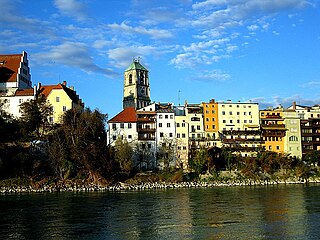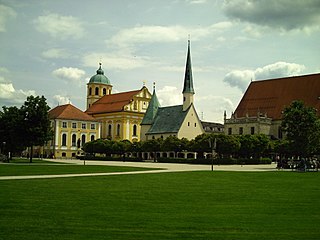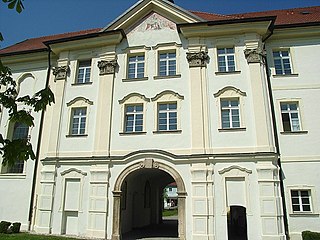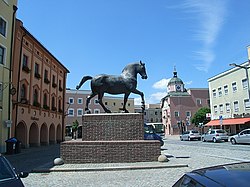Altötting is a Landkreis (district) in Bavaria, Germany. It is bounded by Austria and the Bavarian districts of Traunstein, Mühldorf and Rottal-Inn.
Passau is a Landkreis (district) in the southeast of Bavaria. It encloses the city of Passau geographically from two sides. Neighboring districts are Rottal-Inn, Deggendorf, Freyung-Grafenau. To the south it borders Austria.
Dingolfing-Landau is a Landkreis (district) in Bavaria, Germany. It is bounded by the districts of Straubing-Bogen, Deggendorf, Rottal-Inn and Landshut.
Rottal-Inn is a Landkreis (district) in the southeastern part of Bavaria, Germany. Neighboring districts are Altötting, Mühldorf, Landshut, Dingolfing-Landau and Passau. To the southeast is the Austrian state Upper Austria (Braunau).

Wasserburg am Inn is a town in Rosenheim district in Upper Bavaria, Germany. The historic centre is a peninsula formed by the meandering river Inn. Many Medieval structures remain intact, giving the city a unique view.

Altötting is a town in Bavaria, capital of the district Altötting of Germany. For 500 years it has been the scene of religious pilgrimages by Catholics in honor of Mary, including a visit by Pope John Paul II in 1980 and one by Pope Benedict XVI in 2006.

Simbach am Inn is a town on the River Inn in the Rottal-Inn district of Bavaria, Germany. The Austrian city Braunau am Inn lies on the opposite side of the river from Simbach.

Randersacker is a market town and municipality in Lower Franconia, a part of Bavaria, Germany. With its long tradition in wine making, Randersacker is a well-known wine places of Germany. It lies in the Würzburg district, and adjoins to Würzburg boroughs Heidingsfeld, Rottenbauer, Sanderau and Frauenland and to the municipalities of Gerbrunn, Theilheim and Eibelstadt.

Aldersbach is a municipality in the district of Passau in Bavaria in Germany. The former Cistercian Aldersbach Abbey, of which the Baroque church remains, is located in the village. There is also a brewery with museum. Aldersbach has around 4,500 inhabitants.

Dingolfing is a town in southern Bavaria, Germany. It is the seat of the Landkreis (district) Dingolfing-Landau. Dingolfing is home of a BMW assembly plant.

Grafing bei München is a town in the district of Ebersberg, Upper Bavaria, Germany.

Wörth am Main is a town in the Miltenberg district in the Regierungsbezirk of Lower Franconia (Unterfranken) in Bavaria, Germany. It has a population of around 4,700.

Lenggries is a municipality and a town in Bavaria, Germany. It is the center of the Isarwinkel, the region along the Isar between Bad Tölz and Wallgau. The town has about 9,500 inhabitants. By area, it is the largest rural municipality ("Gemeinde") in what was formerly West Germany, and the 7th-largest overall.

Velden is a market town and municipality in the district of Landshut in Bavaria in Germany.

Kirchdorf am Inn is a municipality in the district of Rottal-Inn in Bavaria in Germany. It lies on the river Inn.

Mitterskirchen is a municipality in the district of Rottal-Inn in Bavaria in Germany.

Tann is a municipality in the district of Rottal-Inn in Bavaria, Germany. It has about 4,000 inhabitants and is 15 km from the corner of Austria away. Notable sites include the historic marketplace and the church St. Peter and Paul.

Zeilarn is a municipality in the district of Rottal-Inn in Bavaria, Germany.

Gangkofen is a municipality in the county ("Landkreis") of Rottal-Inn in Bavaria in Germany.

The Rottaler is a German breed of riding and carriage horse of heavy warmblood type. The name derives from that of the Rottal, the valley of the Rott in the Landkreis of Rottal-Inn in south-eastern Bavaria. It is critically endangered. The Bavarian Warmblood derives from it.





















